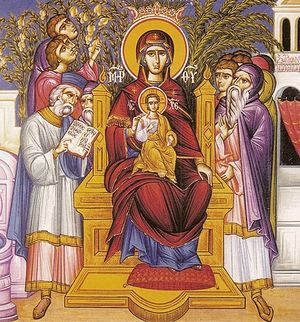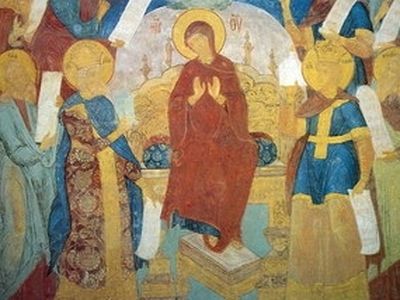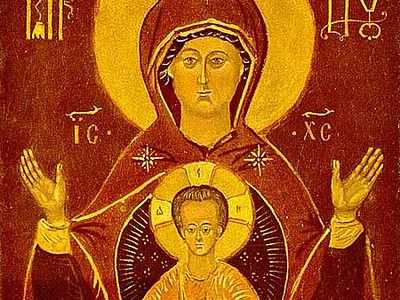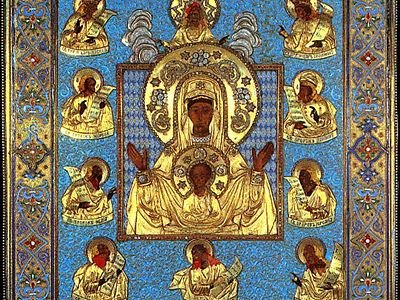The Akathist Hymn is one of the most well-loved services of devotion in the Orthodox Church. Although there is some debate concerning the particulars of its authorship, many scholars agree with the pious tradition which states that the Akathist was composed in the imperial city of Constantinople, "the city of the Virgin," by St. Romanos the Melodist, who reposed in the year 556. The Akathist Hymn has proved so popular that many other hymns have been written following its format, particularly in the Russian Orthodox Church. These include Akathists to Our Lord Jesus Christ, to the Cross, to various saints, etc.
The word "akathistos" literally means "not sitting," i.e., standing; normally all participants stand while it is being prayed. The hymn is comprised of 24 stanzas, alternating long and short. Each short stanza (kontakion) ends with the singing of "Alleluia." Each longer stanza (ikos) ends with the refrain: "Rejoice, O Bride Unwedded."
The majority of the hymn is made up of praises directed to the Mother of God, always beginning with the salutation of the Archangel Gabriel: "Rejoice." In each of them, one after the other, all the events related to our Lord's incarnation pass before us for our contemplation. The Archangel Gabriel (in Ikos 1) marvels at the Divine self-emptying and the renewal of creation which will occur when Christ comes to dwell in the Virgin's womb. The unborn John the Baptist (Ikos 3) prophetically rejoices. The shepherds (Ikos 4) recognize Christ as a blameless Lamb, and rejoice that in the Virgin "the things of earth join chorus with the heavens." The pagan Magi, (Kontakion 5) following the light of the star, praise Her for revealing the light of the world.
As the hymn progresses, various individuals and groups encounter Christ and His Mother. Each has his own need; each his own desire or expectation, and each finds his or her own particular spiritual need satisfied and fulfilled in Our Lord and in the Mother of God. So too, each generation of Orthodox, and each particular person who has prayed the Akathist, has found in this hymn an inspired means of expressing gratitude and praise to the Mother of God for what she has accomplished for their salvation.
* * *
Why we say “Rejoice” in the Akathist, by Hieromonk Job (Gumerov)
As a genre of Christian hymnography, the Akathist (from the Greek, akathistos, where a is the negative particle, kathizein means “to sit; literally, “not sitting”) is distinguished not only by its construction, but also by its especially joyful mood. This can be explained by the actual circumstances under which the first Akathist was composed. It was written in honor of the Mother of God, and was sung, standing all night, from Friday to Saturday of the fifth week of Great Lent, after the victory over the Persians and Avars who had attacked Constantinople in 626, with Shah Hosroes Sarvar as their leader. The imperial city was surrounded by sea and by land. The situation was hopeless. The Mother of God gave Her miraculous help, and the city was saved. (Queen of the heavenly hosts, defender of our souls, we thy servants offer to Thee a song of victory, for Thou… hast delivered us from danger.”) Out of thanksgiving for this intercession, the feast of the Laudation of the Most Pure Mother of God (Saturday of the Akathist) was instituted. The word “rejoice” pronounced repeatedly is taken from the Gospels. This is how the Archangel Gabriel greeted the Mother of God when he brought her the annunciation of the Messiah Who would be born of Her: Rejoice, Thou who are full of grace! The Lord is with Thee. Blessed art Thou among women (Lk. 1:28). In Akastists written to saints, which were composed according to the example of this first Akathist, the call, “rejoice” is also present. The Gospels also give a basis for this. Through their labors of faith and life, the saints were made worthy of the reward about which the Savior speaks in His beatitudes: Rejoice and be glad, for great is your reward in the heavens (Mt. 5:12).
The composition of the Akathist is, according to some traditions, attributed to the deacon of the Great Constantinople Church, George Pisidis. At first the service was sung only in the Blachernae Church, where the miraculous icon of the Mother of God Hodigitria, and the tunic and cincture of the Mother of God were kept. But in the ninth century, the feast of the Laudation of the Mother of God was instituted into the typicon of the monasteries of the Studion and St. Savva the Sanctified, and then into Lenten Triodion. Thus did this special feast day become part of the entire Orthodox Church.
Besides the Saturday of the fifth week of Great Lent, Akathists to the Savior, the Mother of God, and to the saints are often read outside of Lent, during which Christians should especially pray for forgiveness of sins. We often turn to Akathists during times of particular joy and thankfulness, or when we need to ask help from the Lord and the Mother of God in trying situations.
* * *
Archimandrite Ephrem (Lash) on his translation of the Akathist to the Mother of God:
The authorship of the Akathist Hymn to the Mother of God is the subject of much learned discussion, though many reputable scholars attribute it to St Romanos the Melodist, and so I have put this tentative translation on his page. The poem defies every translator and it is virtually impossible [to include] all the rhetorical devices which are such a striking feature of the Greek original. The original has an alphabetical acrostic for the first word of each Kontakion and Ikos, and the lines beginning ‘Hail!’ are marked by many internal rhymes. These are indicated in the translation by em rules.
I have translated the Greek ‘Chaire!‘ by ‘Hail!’ as this is the most natural meaning of the Greek. Even though etymologically it means ‘Rejoice!’, it is a standard greeting, like the Latin ‘Ave!‘, which is what the Roman soldiers presumably said to the Lord as they mocked him. In the New Testament it often translates the Hebrew ‘Shalom!’
Liturgically the Hymn forms part of Matins on the Saturday of the Akathist, and in the monasteries of the the Holy Mountain it is read each night at Compline. In Greek use it is chanted solemnly in four sections at Compline on the first four Fridays of Lent, the whole being chanted at Compline on the fifth, the eve of Akathist Saturday."





